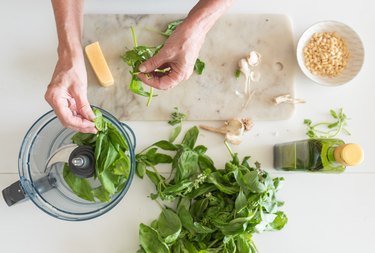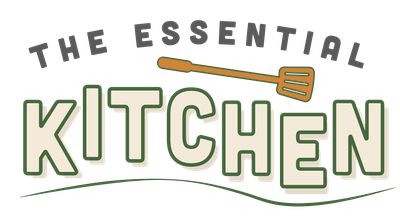
Whether it's fresh hummus or flavorful marinades, food processors are a handy kitchen appliance that can whip up all kinds of dishes in a jiffy.
However, food processor newbies shouldn't be intimidated by this gadget's clunky appearance (or many push-button controls!), as they can be easy and save you time — once you know to use them properly.
To help kitchen novices navigate the realm of food processors like a pro, we tapped four kitchen pros (nutritionists included) to break down all the ins-and-outs concerning this popular kitchen aid.
What Is a Food Processor Used For?
In short, a food processor is essentially an appliance that allows you to chop, puree, shred or slice foods super quickly, according to Veronica Dailey, chef and culinary arts professor at Cuesta College in San Luis Obispo, California.
Food processors help speed up the cooking process, allowing you to skip out on lengthy meal prep time.
Most food processor appliances usually come with plug and blade attachment parts that can be used for any of the different food prep methods such as chopping vegetables and grating cheese, Dailey says. These same parts either be hand-washed or placed inside the dishwasher for a complete clean.
Ready to get started? Chef and dietitian Abbie Gelmann, RD explains exactly how to use your food processor:
- Lock the bowl in place: The bowl should fit in a specific way on the base and be able to rotate and lock in place.
- Select the blade: Food processors have different blades, so you'll need to decide if you want to chop, slice, shred or julienne. Once you pick the blade, place it in the bowl. There should be a circle in the middle of the bowl where the middle of the blade fits like a puzzle piece.
- Fill the bowl: Depending on what you're prepping, this step may be optional. If you're pureeing a bunch of beans to make hummus, for example, you will add the items now. However, if you are going to julienne a bunch of carrots, you can skip this step.
- Close the lid: Be sure to close the lid properly and lock in place. The machine will not start if all the locking mechanisms are not aligned and locked in properly.
- Turn on: Turn on the food processor. There may be a "pulse" option where you control when the blades move and for how long or you can simply turn it to on and it will chop continually until you turn it off.
- Use the feed tube: If you're going to julienne carrots, as mentioned in step 3, you will add the food into the bowl via the feed tube. Many special blades require that you feed food into the bowl using this tube. There is a plastic pusher to help push the food in if necessary. For other foods, such as a bean dip, you may want to add a liquid like oil while the processor is running. The feed tube would be used for this as well.
- Turn off: You may want to turn off the food processor periodically, open the lid, and add more ingredients or to use a spatula to wipe down the sides and reincorporate the ingredients together. Once finished, you can turn off the processor, remove the lid, unlock the bowl, carefully remove the blade and pour the contents into a regular mixing bowl or container.
Since food processors can chop and slice ingredients with ease, they can be used to help create a variety of different dishes.
"Food processors are extremely versatile appliances with many uses," chef and nutritionist Serena Poon, CN, tells us. "This includes finely chopping and slicing vegetables, making salsas, pesto, making nut butters and even kneading dough."
How a Food Processor Can Help You Get More Veggies
Vegetables are one of the best food ingredients used inside as a food processor, according to Poon, as the appliance’s blades work fast to chop and dice everything from red peppers to chives. Here are a few ideas to use your processor on veggies:
- Grate carrots and celery to add to soups
- Grind chickpeas to make hummus
- Chop onions and garlic to add to homemade marinara sauce
- Chop parsley and celery to toss over green salads for added crunch
Svetlana Savchitz, New York restaurateur and owner of Sveta, a restaurant and bar in NYC, encourages getting creative with this handy tool in order to whip up tasty meals — even breakfasts and desserts.
"A food processor allows you to do things like slice veggies, shred cheese, grind meats, beat eggs and more," she says. "At my restaurant Sveta, I love using processors to make the pastry crust for our dessert menu."

How Do Food Processors and Blenders Compare?
It's easy to confuse food processors with blenders, as they both look alike at first glance.
However, Poon suggests they are actually two very different appliances used for completely different purposes, with food processors being the more versatile tool in the long run.
"Blenders are generally used for liquid-based creations such as smoothies, soups or purees," Poon says. "Food processors are used for finely chopping tougher produce like vegetables or nuts, and for making consistent sauces. Food processors are a bit more versatile, but it depends on what you're looking to make. You really can't make a smoothie in a food processor."
Dailey says blender and food processor blades also work differently.
"A blender uses a motion that pulls the food down towards the blade and creates a creamy substance if blended for long enough," Dailey says. "A food processor purees food in a circular motion (not pulling the food down towards the blade), so this creates more of a chopped or pureed substance."
Are Food Processors Worth the Money?
Whether you are a beginner chef or a master restaurateur, Poon says food processors are a great investment buy, as they make a lot of recipes more convenient and are a gateway to healthier eating.
"I find that people tend to eat healthier when they have food processors," she says. "The difference in taste and nutrient value between a homemade dressing and a store-bought dressing, for example, can really be consequential."
And since these appliances range in a variety of different prices and sizes, they can be an economical way to help you create delicious meals at home instead of opting for takeout all the time.
Looking to Buy a Food Processor?
Check out this guide to The 9 Best Food Processors for Every Budget, Kitchen Size and Cooking Task.
What Can I Use Instead of a Food Processor?
If you don't have a food processor on hand, the following tools can help you achieve similar results:
- A hand grater for chopping
- A knife for chopping
- A mandoline for slicing
Bakers who use food processors can also turn to a mixer in order to make dough, mix cake batter and make meringues.
And yes, a blender can accomplish some of a food processor's tasks including making purees, juices and grinding — but you won't want to use one in lieu of a processor for certain foods like sauces, as the texture won't be as consistent, Poon says.
